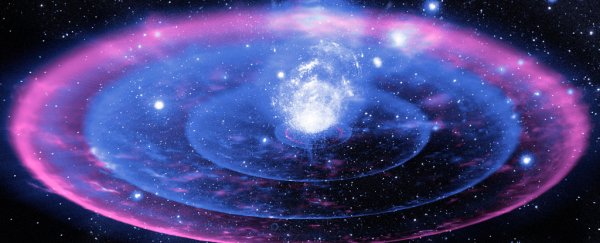Far down in the periodic table you'll find a list of heavy elements born in chaos. The kind of chaos you might find in an exploding star perhaps, or a collision between two neutron stars.
Physicists have uncovered a pair of large, still-radioactive isotopes in samples of deep-sea crust pulled up from 1,500 meters (nearly 5,000 feet) below the Pacific Ocean.
We'd expect to see many heavyweight elements in the swirl of dust and gas that formed our planet eons ago - but most should have decayed into more stable forms long before now. So finding examples in Earth's crust close to the surface today raises some interesting questions.
The finding could tell us a thing or two about cataclysmic cosmic events taking place within a few hundred light-years from Earth, and relatively recently in our geological history. It could also shine a light on the way atomic heavyweights form.
You see, building atoms takes a lot of energy. Protons can be squeezed into helium under the kind of gravity you'd find in a star, but stellar fusion will only take you so far. To build a chunky behemoth such as plutonium, you'll need the kind of energy that can deliver a machine-gun burst of neutrons.
There are a few conditions in the Universe under which this 'rapid neutron capture', or r-process, can occur, including supernovae and neutron star mergers.
Over the history of the Universe, plenty of stars have crashed and popped to spill a thick dust of iron, uranium, plutonium, gold, and other fat atoms throughout the galaxy. So it's to be expected that planets like Earth would have scooped up a good amount of them.
But not all elements are born the same. Variations in the number of their neutrons make some more stable than others. Iron 60, for example, is a 'blink and you'll miss it' kind of isotope if you view it on the cosmic scale, with a half-life of just 2.6 million years before it decays into nickel.
Finding this short-lived isotope on our planet today – especially in the crust, just out of reach of modern artificial processes – would imply a relatively recent delivery of iron fresh from the cosmos.
Iron 60 has appeared in rock samples before, dating back just a couple of million years. It's also been seen in materials brought back from the lunar surface.
But to get a good sense of the specific kind of r-process that produced these specimens, it would pay to see what other isotopes rained down with them.
Physicist Anton Wallner from the Australian National University led a team of researchers in search of new samples of iron 60 to see if they could identify isotopes of other heavy elements close by.
What they found was plutonium 244, an isotope with a half-life of just over 80 million years – stable for plutonium, but hardly the kind of element you'd expect to stick around since our planet came together 4.5 billion years ago.
In all, the team discovered two distinct influxes of iron 60 which had to have arrived within the past 10 million years. Both samples were accompanied by small but significant quantities of plutonium 244, each in a similar ratio.
Finding them together adds more detail than finding either apart. The amount of plutonium in them is lower than would be expected if supernovae were primarily responsible for their production, pointing to contributions from other r-processes.
Exactly what was behind this particular sprinkle of alien space dust is left up to our imagination for now.
"The story is complicated," says Wallner.
"Possibly this plutonium-244 was produced in supernova explosions or it could be left over from a much older, but even more spectacular event such as a neutron star detonation."
By measuring their respective radioactive fuses and making a few assumptions on the astrophysics behind their distribution, the researchers speculate the production of iron 60 is compatible with two to four supernova events going off between 50 and 100 parsecs (around 160 and 330 light years) of Earth.
This isn't the first time iron 60 has indicated a supernova taking place perilously close by in recent history.
By looking at the isotope in connection with other elements, we could slowly build a signature that tells us more about the crash-bang conditions of our neighborhood in the millions of years before humans started to pay close attention.
It'll take more hunting for alien isotopes, though.
"Our data could be the first evidence that supernovae do indeed produce plutonium-244," says Wallner.
"Or perhaps it was already in the interstellar medium before the supernova went off, and it was pushed across the Solar System together with the supernova ejecta."
This research was published in Science.
